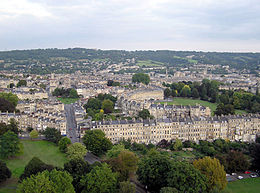| UNESCO World Heritage Site | |
|---|---|
 Aerial view over northern Bath from a hot air balloon. The famous Royal Crescent is in the centre. | |
| Location | Bath, Somerset, United Kingdom |
| Criteria | Cultural: (i), (ii), (iv) |
| Reference | 428 |
| Inscription | 1987 (11th Session) |
| Area | 2,900 ha (7,200 acres) |
| Coordinates | 51°22′53″N 2°21′31″W / 51.38139°N 2.35861°W |
| Part of | Great Spas of Europe |
| Criteria | Cultural: (ii), (iii) |
| Reference | 1613 |
| Inscription | 2021 (44th Session) |
The buildings and architecture of Bath, a city in Somerset in the south west of England, reveal significant examples of the architecture of England, from the Roman Baths (including their significant Celtic presence), to the present day. The city became a World Heritage Site in 1987, largely because of its architectural history[1] and the way in which the city landscape draws together public and private buildings and spaces.[2] The many examples of Palladian architecture are purposefully integrated with the urban spaces to provide "picturesque aestheticism".[2] In 2021, the city was added to a second World Heritage Site, a group of historic spa towns across Europe known as the "Great Spas of Europe". Bath is the only entire city in Britain to achieve World Heritage status,[3][4] and is a popular tourist destination.
Important buildings include the Roman Baths; neoclassical architect Robert Adam's Pulteney Bridge, based on an unused design for the Rialto Bridge in Venice;[5] and Bath Abbey in the city centre, founded in 1499[6] on the site of an 8th-century church.[7] Of equal importance are the residential buildings designed and built into boulevards and crescents by the Georgian architects John Wood, the Elder and his son John Wood, the Younger – well-known examples being the Royal Crescent, built around 1770, and The Circus, built around 1760, where each of the three curved segments faces one of the entrances, ensuring that there is always a classical facade facing the entering visitor.
Most of Bath's buildings are made from the local, golden-coloured, Bath Stone. The dominant architectural style is Georgian,[8] which evolved from the Palladian revival style that became popular in the early 18th century. The city became a fashionable and popular spa and social centre during the 18th century. Based initially around its hot springs, this led to a demand for substantial homes and guest houses. The key architects, John Wood and his son, laid out many of the city's present-day squares and crescents within a green valley and the surrounding hills. According to UNESCO this provided... "an integration of architecture, urban design, and landscape setting, and the deliberate creation of a beautiful city".[2] Development during modern eras, including the development of the transport infrastructure and rebuilding after bomb damage during World War II, has mostly been in keeping with earlier styles to maintain the integrated cityscape.
- ^ "City of Bath World Heritage Site Management Plan – Appendix 3". Bath and North East Somerset Council. Archived from the original on 4 August 2007. Retrieved 2007-11-01.
- ^ a b c "City of Bath". World Heritage. UNESCO. Archived from the original on 3 October 2009. Retrieved 24 October 2009.
- ^ "United Kingdom of Great Britain and Northern Ireland". World Heritage. UNESCO. Archived from the original on 17 September 2009. Retrieved 21 September 2009.
- ^ "Bath keeps world heritage status". BBC News. 25 June 2009. Archived from the original on 23 January 2021. Retrieved 21 September 2009.
- ^ Cite error: The named reference
pultneywas invoked but never defined (see the help page). - ^ "Home Page". bathabbey.org. Archived from the original on 24 November 2009. Retrieved 11 November 2009.
- ^ John Britton, The history and antiquities of Bath Abbey church, page 18. Harvard University, 1825. 1825. Archived from the original on 2 July 2023. Retrieved 11 November 2009.
- ^ Cite error: The named reference
gaddwas invoked but never defined (see the help page).

